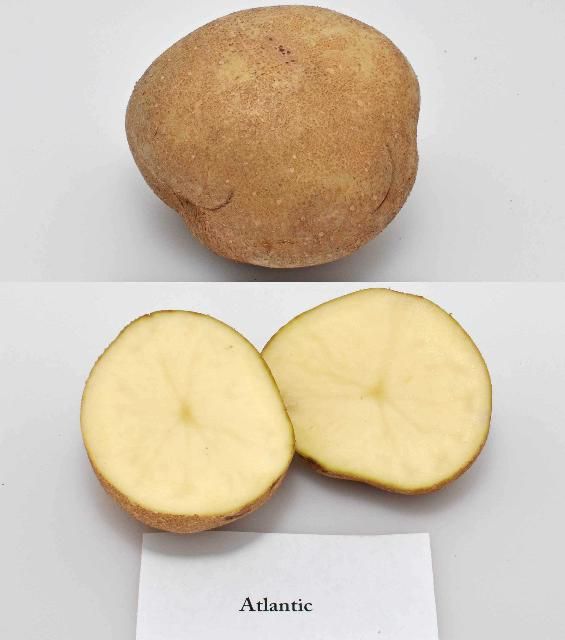There are several potato varieties available in the market today. Most of them have been bred or developed in production regions other than Florida. The University of Florida Potato Variety Evaluation Program screens new germplasm from public and private breeding programs and identifies the most promising cultivars for commercial potential considering broad adaptability to Florida climate and conditions and market purpose: processing, fresh-market and specialty-type varieties. Over the years, the UF/IFAS Potato Variety Program has become an important reference to vegetable growers, seed producers, processors, crop insurance agencies, and brokers looking for alternative potato varieties to explore different markets, improved characteristics, and yield. This UF/IFAS Potato Variety Trials Spotlight presents a summary of the field evaluation of tuber yield and quality performance of the potato variety 'Atlantic' cultivated in Florida.
General Comments
'Atlantic' is a white-skinned potato and the standard variety for chipping commonly cultivated in Florida (Figure 1). The cultivar was released as a white mutant of the USDA breeding program. It was selected from a cross of Wauseon and Lenape (UDSA seedling B5141-6). 'Atlantic' was released in July 1976 by the Agricultural Research Service of the USDA, the Florida Agricultural Experiment Station, the Virginia Truck and Ornamentals Research Station, the New Jersey Agricultural Experiment Station, and the Maine Agricultural Experiment Station (Webb et al. 1978). Production and quality results provided in this spotlight are summarized from various trials conducted by the University of Florida over the past 22 years.

Credit: Lincoln Zotarelli, UF/IFAS
General Characteristics
'Atlantic' tubers are smooth with an oval to round shape. Its white skin has light to heavy scaly net touch. In heavy soils or areas with high organic matter, the skin may be dark. The variety has shallow to intermediate deep-white eye and white internal flesh color. It is a high-yielding variety with an average specific gravity around 1.077, adapted for Florida growing conditions (Tables 1, 2, and 3).
Season Length and Growth
The length of time from planting to harvesting is approximately 85 to 110 days, depending on growing conditions during the season. For Florida conditions, the season length was on average 99 days. Late in the season, tuber size should be checked regularly. 'Atlantic' typically shows rapid vegetative growth between 40 and 75 days after planting (Rens et al. 2015). It matures during the middle to late portions of the season.
Fertilization
University of Florida trial plots were fertilized with 200 lb/acre of N, with 50 lb/acre of N (granular) incorporated into the beds prior to planting, followed by two split side-dress fertilizer applications of 75 lb/acre of N each at emergence and at tuber initiation. Phosphorus and potassium application follow the UF/IFAS guidelines described in Liu et al. (2019) and normally range between 45 to 100 lb/ac of P2O5 and 170 to 235 lb/ac of K2O.
Planting
A seed piece of 2½ to 3 oz is recommended for planting. The crop should be planted with 36 to 42 inches between rows, 7 to 10 inches between plants, and 3 to 4 inches deep. A seed rate of 2,000 to 3,000 lb/acre seed is expected.
Seed Source
Seed for the trial was provided from many sources, including Maine Farmer's Exchange (MFX), University of Maine, USDA-ARS Presque Isle, and Maine growers.
Diseases
The cultivar is tolerant to scab and Verticillium wilt; resistant to pinkeye; and highly resistant to Race A of golden nematode, virus X, and tuber net necrosis. Tubers are susceptible to internal heat necrosis, particularly in sandy soils and during warm, dry seasons. In some areas, hollow heart can be serious in large tubers (diameter >3 in), especially when growing conditions fluctuate during the season.
Other Information
For additional information on cultivation and management, see the Potato Production chapter of the Vegetable Production Handbook, available at https://edis.ifas.ufl.edu/cv131.
References
Hutchinson, C. M., J. M. White, D. M., Gergela, P. A. Solano, K. G. Haynes, R. Wenrich, and C. S. Lippi. 2003. "Performance of chip processing potato varieties in northeastern Florida." HortTechnology 13 (4): 706–711.
Liu, G., E. H. Simonne, K. T. Morgan, G. J. Hochmuth, S. Agehara, and R. Mylavarapu. 2019. Chapter 2. Fertilizer Management for Vegetable Production in Florida. In Vegetable Production Handbook of Florida, 2019–2020 Edition. CV296. Gainesville: University of Florida Institute of Food and Agricultural Sciences. https://edis.ifas.ufl.edu/cv296
Rens, L. R., L. Zotarelli, D. J. Cantliffe, P. J. Stoffella, D. Gergela, and D. Fourman. 2015. "Biomass Accumulation, Marketable Yield, and Quality of Atlantic Potato in Response to Nitrogen." Agronomy Journal 107:931–942.
Sisson, J. A., and G. A. Porter. 2002. "Performance evaluations of potato clones and varieties in the northeastern states-1999." Maine Agr. For. Expt. Sta., Misc. Publ. 751.
Webb, R. E., D. R Wilson, J. R. Shumaker, B. Graves, M. R. Henninger, J. Watts, and H. J. Murphy. 1978. "Atlantic: A new potato variety with high solids, good processing quality, and resistance to pests." American Journal of Potato Research 55 (3): 141–145.
Summary of production statistics and specific gravity of 'Atlantic' potato variety grown at the UF/IFAS Hastings Agricultural Extension Center, Hastings, FL.